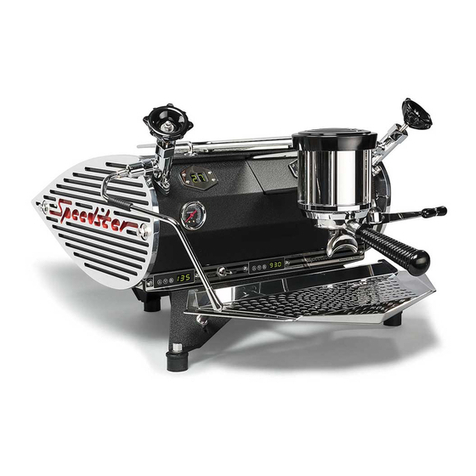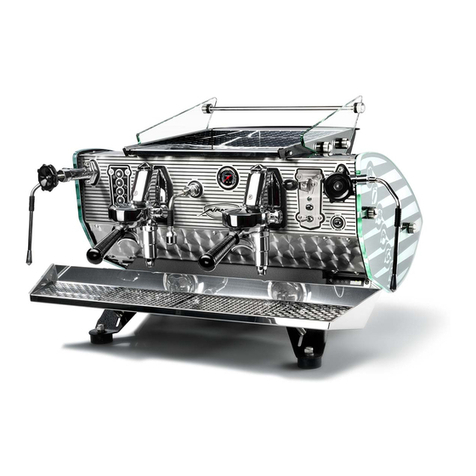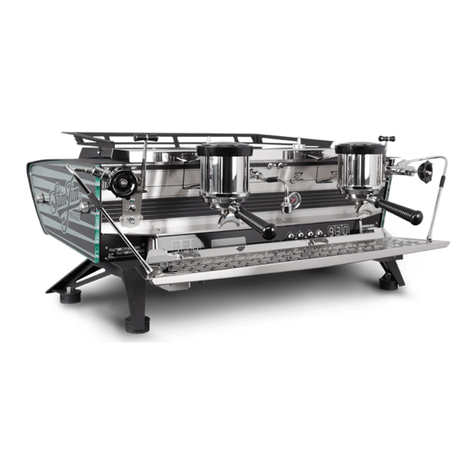INSTALLATION
Speedster page 9
Connect to mains power and switch on
Warning! The Speedster is made for either 110-120VAC or 220-240VAC power supply. Make sure
that the power demands (see identity tag on front of machine) matches the local power
supply before connecting the Speedster to the mains power. We cannot be held responsible
for damages resulting from connecting the machine to incompatible mains power.
Beware!
A 220-240 VAC Speedster has a maximum power consumption of 3100 Watts from your AC-outlet
(max. power consumption limiter is disabled). This occurs when all three heating spirals and the pump
are active simultaneously. At 230 Volts this is equivalent to approximately 13.5 amps. We therefore
recommend that the machine has its own dedicated power circuit breaker. The max. power
consumption limiter can be made active to reduce maximum power consumption to 2300 Watts, 10
amps at 230 VAC; see leaflet that came with the Speedster.
If you have ordered a 110-120 VAC version of the Speedster (max. power consumption limiter is
active; 2050 Watts, 17.8 amps at 115VAC), you must connect your power mains to a 110-120 VAC
power outlet. The pump is fed from the Speedster and the pump-motor will be marked 110-120 VAC
as well. Where we speak of 230 VAC in the rest of this manual, you should read 110-120 VAC.
1. Make sure that the mains switch is in the "OFF"-position. The mains switch is mounted on the
identity tag on the front of the machine (see Figure W 1, item 1).
2. The thinner electrical cable attached to the Speedster is the pump cable (see Figure I 3) and
has a special type of connector. Attach the pump cable to the pump motor using the special
connectors.
3. Attach the other cable to a 230 VAC earthed power outlet. If your Speedster came without a
mains plug, it is advised to attach the blue wire to the neutral in your power outlet. (Although
there is no difference in operational aspect, this makes it easier to check the electrics in case
of a malfunction.)
4. Make sure that the Speedster rests on its feet.
5. Put the 3-way brewing lever on the right hand side of the machine (Figure W 1, item 4) in the
lowest position (Figure U 1 “pump active”).
6. Turn the mains switch on the machine to “ON”, the coffee boiler filling is continued.
7. Wait until water without air leaves the group. This procedure expels all air from the coffee
boiler. A separate bleeding procedure is not needed.
8. After this move the lever in its high “off” position. The machine will now automatically fill its
steam boiler.
The displays of both temperature regulators (see Figure W 1, items 2 & 17) will not show any value
until a minimum water level in the steam boiler is reached. Filling procedure will continue till it reaches
the maximum (operational) level.
When the temperature in the steam boiler reaches boiling point some steam will escape through the
anti-vacuum valve which makes a hissing or sputtering sound inside the machine. This will stop when
the valve is shut by the increasing pressure inside the steam boiler.
Adjust pump pressure
The right hand side pressure gauge displays the pressure in the coffee boiler. The minimum value
when the machine is at rest is the line pressure of the incoming tap water (as in other water taps in
your house). Factory setting of the maximum pressure in the boiler is 11-13 bar. Above this value an
expansion valve on the machine will open thus bleeding excessive pressure until the maximum value
is no longer exceeded (this occurs when water with a lower temperature than the set value enters the
coffee boiler, heats up and thus expands).






































